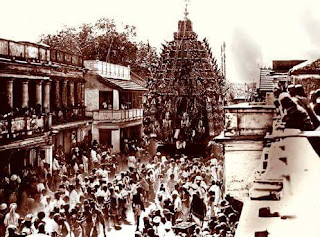Mylapore Ther festival 1855
A first hand description of the Ther festival in Mylapore in 1855 AD from a American Missionary travelogue:
"Turning into the street upon the opposite side of the tank, we found ourselves before the temple. Here the mass centered and the religious beggars and devotees were most numerous. Near the temple gate sat some wearing the Cavi or yellow robe of their order, besmeared all over with ashes and with their filthy and uncombed hair hanging in clotted string to their shoulders. Others went through the crowd with wires run through their tongue or cheeks, mincing and dancing with a disgusting air. Attendants carried small brass plates for alms, which they thrust into the faces of people. Here, too stood the Car the centre of attraction. It is a unwieldy structure square and pyramidal and resting upon four great solid wooden wheels, six feet in diameter. Above it consists of several stories growing smaller as they near the top and ending in small gilt umbrella. The whole was decorated with bands of cloth, garlands of flowers to give an imposing appearance. Upon the first story of the car was the throne of the God. Wrapped in costly robes and adorned with jewels and flowers it could scarcely be seen for its ornaments. Besides it stood Brahmin priests fanning the silver thing with cow tail brushes lest it should be molested by flies or heat.
The firing of small cannon announced the hour of starting. The Brahmins in the car shouted to the mob, and waving their sacred brushes incited them to their work. The men rushing forward seized the great cables each as thick as a man's thigh and laid them on their shoulders. Arrayed in two long lines they attempt to start the ponderous car. Again the Brahmins shout and cry to the mob and again the mob answering to the cry put forth their strength. The priests urge them on and now another strain, and the towering pile, grating harshly on its wheels moves slowly through the street. Old men, who cannot help, lift up their hands in homage; and mothers rushing forward hold up their babes to catch a sight of the God".
"Turning into the street upon the opposite side of the tank, we found ourselves before the temple. Here the mass centered and the religious beggars and devotees were most numerous. Near the temple gate sat some wearing the Cavi or yellow robe of their order, besmeared all over with ashes and with their filthy and uncombed hair hanging in clotted string to their shoulders. Others went through the crowd with wires run through their tongue or cheeks, mincing and dancing with a disgusting air. Attendants carried small brass plates for alms, which they thrust into the faces of people. Here, too stood the Car the centre of attraction. It is a unwieldy structure square and pyramidal and resting upon four great solid wooden wheels, six feet in diameter. Above it consists of several stories growing smaller as they near the top and ending in small gilt umbrella. The whole was decorated with bands of cloth, garlands of flowers to give an imposing appearance. Upon the first story of the car was the throne of the God. Wrapped in costly robes and adorned with jewels and flowers it could scarcely be seen for its ornaments. Besides it stood Brahmin priests fanning the silver thing with cow tail brushes lest it should be molested by flies or heat.
The firing of small cannon announced the hour of starting. The Brahmins in the car shouted to the mob, and waving their sacred brushes incited them to their work. The men rushing forward seized the great cables each as thick as a man's thigh and laid them on their shoulders. Arrayed in two long lines they attempt to start the ponderous car. Again the Brahmins shout and cry to the mob and again the mob answering to the cry put forth their strength. The priests urge them on and now another strain, and the towering pile, grating harshly on its wheels moves slowly through the street. Old men, who cannot help, lift up their hands in homage; and mothers rushing forward hold up their babes to catch a sight of the God".




Comments